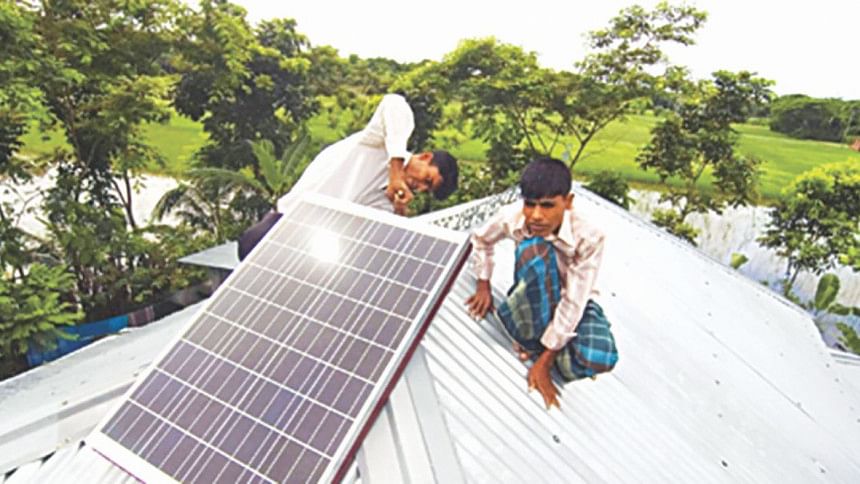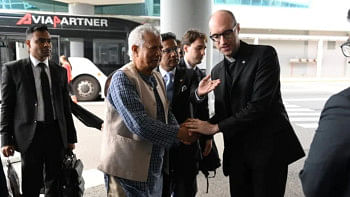An alternative energy future for Bangladesh

Off the coast of Bangladesh sits the small island of Manpura. Shaped like a banana when viewed from above, this will be the country's first "green island" powered by only renewable energy.
Dreamt up by the Sustainable and Renewable Energy Development Authority, as part of a larger initiative to provide renewable energy to 250 other hard-to-reach places, Manpura will be powered by a mix of solar, wind and biogas.
"We want to make it a green island," explained Siddique Zobair from the energy authority. "This is part of the plan to ensure electricity to all by 2021."
While it is great that the country is investing in renewable energy, if you look at the overall picture, the nation's main energy source in a few years will be coal.
And that is a problem. Because burning coal means greenhouse gases, and that means climate change. And as everyone knows, Bangladesh is at risk of climate change.
Now renewable energy is still part of the government's plan, but it's a little unclear to what extent.
The renewable energy policy from 2008 sets the goal at ten percent renewable energy by 2020, whereas the power master plan from 2016 has the goal at three percent for 2021. Not to mention, last year, Bangladesh along with other climate vulnerable countries at the UN climate talks committed to 100 percent renewable energy by 2050.
Within the current paradigm of development, which believes every citizen's access to grid electricity is fundamental to the country's ability to develop and grow its economy, an overhaul to renewable energy is unlikely any time soon.
But there might be another way for the country to have a clean energy revolution—it would just require some rethinking of our chosen development pathway.
Coal, coal
Currently, we rely on natural gas for most of our country's energy needs. Yet as the supply of easily accessible natural gas runs out, we have decided to turn to coal.
Over the next few years, the government is planning to build at least a dozen new coal plants to light up the country. While Bangladesh does have its own natural reserve of coal, it is buried fairly deep and so the current proposal is to import coal from India and other nearby countries.
While this may meet the country's growing energy demands—and provide electricity to the millions of households that currently have no access—it will inevitably raise the country's greenhouse gas emissions.
Based on what the government reported to the UN climate body, the country expects to increase emissions almost threefold by 2030.
Like many developing nations, Bangladesh argues it has a right to burn fossil fuels in order to develop. After all, the country has historically emitted very little—less than half a percent of total global emissions.
But it is hard to fully support this argument, knowing full well that Bangladesh is also in great danger of climate change. With a population of 160 million, living in a relatively small area of land, the country faces major challenges in food security and other areas because of such changes in the atmosphere.
Now the government has told the UN climate body it will reduce its projected emissions by five percent, and with international support by 15 percent.
We could be more ambitious, of course, we would just need to imagine an alternative energy future—one that relies far more on off-grid renewable energy.
On becoming a solar nation
Over four million solar home systems have been distributed in Bangladesh over the last five years. That amounts to about 150 mega-watts of electricity servicing close to 20 million people.
But this year, the distribution of solar home systems dropped. The underlying reason (in my opinion, at least): across the country, grid electricity is valued over off-grid renewables.
Somehow solar panels are associated with being backwards in rural Bangladesh, with being poor. In people's mind, only when you are connected to the energy grid do you have any status and are "developed" like the rest of the country.
Making things worse are the lone electric poles that stand tall in villages, built by politicians who have promised access to the grid in a few short years. Why would villagers invest in solar when they are expecting grid access in a few short years?
Another reason why the solar home system market has been saturated is because of a government "food for work" programme, where solar home systems were given out for free, further decreasing their value in people's eyes—nobody wants to buy something others are receiving for free.
Ironically, the customers most likely to purchase solar home systems at the moment are those already on the grid. They are the ones who realise grid power is not always as reliable as they were led to believe.
A brighter future
Perhaps another way forward for Bangladesh is to have a serious discussion about energy futures—both in terms of consumption and production. Most of the work in reducing greenhouse gases has been in reducing CO2 emissions; but on the flip side of that is reducing consumption. Does everybody really need to consume the energy that they do?
There are off-the-grid energy alternatives in Bangladesh that would potentially support rural livelihoods better than the grid—especially with the development of mini-grids spreading, whereby villagers can stock and trade solar energy with their neighbours for a small fee.
And a major benefit of solar home systems is that they are a kind of lo-fi technology, meaning they can be repurposed. This is why many fishermen now light up their boats at night with solar panels.
A decentralised energy infrastructure would also be more resilient to shocks. When the grid breaks down, whole regions are left without power. In a decentralised energy system, even if one solar village lost power all the other villages would remain fine.
Bangladesh was fairly realistic in its pledge to the UN climate body to unconditionally reduce five percent of its projected emissions by 2030. But the country could become even more ambitious in combating climate change if it were to consider off-grid renewable energy as a more central part of its energy infrastructure.
Manpura, and other hard-to-reach sites, would no longer have to be the exception, but the path to a different type of development. They could act as examples of what a decentralised off-grid renewable energy system in Bangladesh could look like.
Meraz Mostafa is a writer who works at the International Centre for Climate Change and Development.





Comments